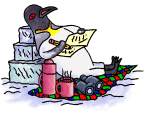 One reason for the uncertainty about the 1998 Giacobinids is
that scientists still have a lot to learn about meteor streams.
We know that comets leave debris behind them,
but does debris also precede the comet?
This week we have a good chance to find out, because Earth
will be passing by Giacobini's orbit in advance of the comet.
So, we're inviting amateur meteor observers to
go out on the night of October 8th, count the shooting stars
they see, and report the data back to us at NASA.
Even if you don't observe any meteors, your null result is valuable. It tells us how
little debris is flying ahead of the comet.
We'll post
a summary of the results on our SpaceWeather.com
site before next month's Leonid meteor shower. One reason for the uncertainty about the 1998 Giacobinids is
that scientists still have a lot to learn about meteor streams.
We know that comets leave debris behind them,
but does debris also precede the comet?
This week we have a good chance to find out, because Earth
will be passing by Giacobini's orbit in advance of the comet.
So, we're inviting amateur meteor observers to
go out on the night of October 8th, count the shooting stars
they see, and report the data back to us at NASA.
Even if you don't observe any meteors, your null result is valuable. It tells us how
little debris is flying ahead of the comet.
We'll post
a summary of the results on our SpaceWeather.com
site before next month's Leonid meteor shower.
Before you rush outside to start counting, there are a few procedures
we need review to ensure that the counts are scientifically meaningful.
The number of meteors you see depends on the light pollution
in your area, the altitude of the shower's radiant, whether or
not the moon is up, etc. All these need to be recorded so we
can make sense of the observations and compare results from different
observers.
 Place a reclining chair (a lawn chair is fine) in a dark site
with an open view of the sky. Dress warmly! You will also need
a dim, red-filtered flashlight and a watch. You can make notes
with a notebook and a pencil, but a tape recorder is even better.
The recorder will allow you to dictate notes in the dark without
taking your eyes off the sky. Before you start real observing,
give your eyes ten minutes to adjust to the dark. The moon will
rise around 9 p.m., so at most Northern latitudes there are only
two reasonably good dark sky hours. After the moon comes up only
the brightest meteors will be visible. Place a reclining chair (a lawn chair is fine) in a dark site
with an open view of the sky. Dress warmly! You will also need
a dim, red-filtered flashlight and a watch. You can make notes
with a notebook and a pencil, but a tape recorder is even better.
The recorder will allow you to dictate notes in the dark without
taking your eyes off the sky. Before you start real observing,
give your eyes ten minutes to adjust to the dark. The moon will
rise around 9 p.m., so at most Northern latitudes there are only
two reasonably good dark sky hours. After the moon comes up only
the brightest meteors will be visible.
Each time you see a meteor, make a check mark on your notepad
or a comment on the voice recorder. Every ten minutes note the
time.
For your counts to be meaningful it is absolutely necessary to
establish the "limiting magnitude" of your night sky.
In other words, what is the dimmest star you can see? For the
Giacobinid meteor shower the best way to check your limiting
magnitude is to look at the little dipper. This
image from Sky
& Telescope shows the magnitudes of stars in the little dipper.
Simply note the magnitude of the dimmest star you can see. That's
your limiting magnitude. |